1、先创建项目
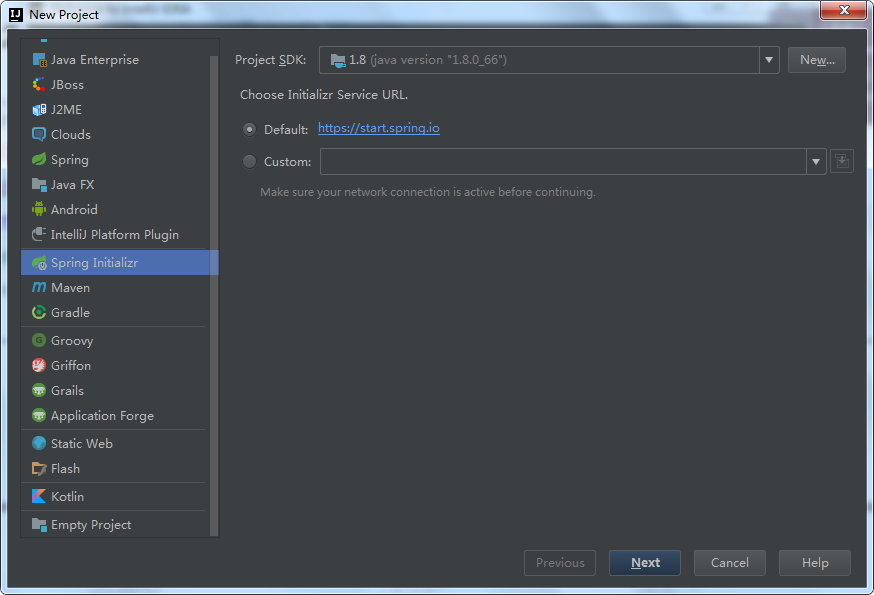
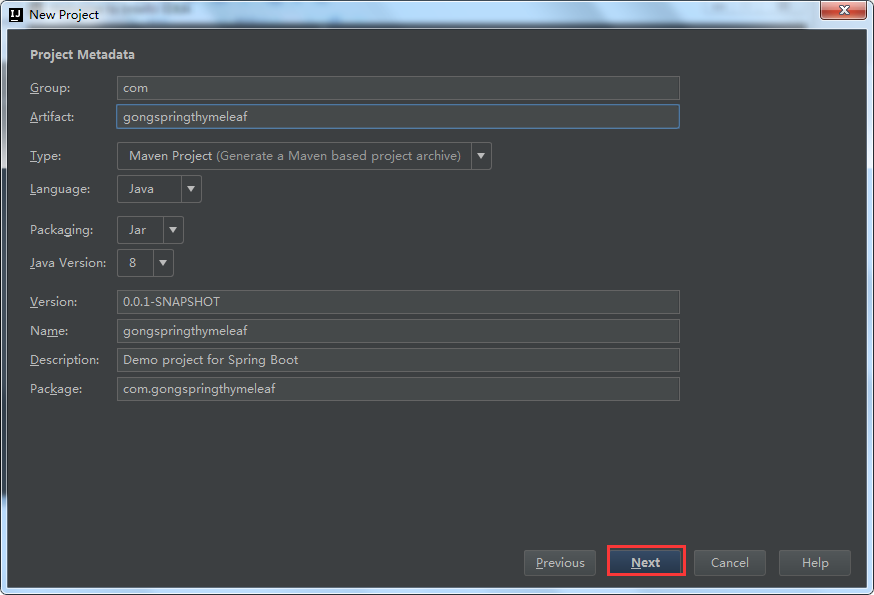
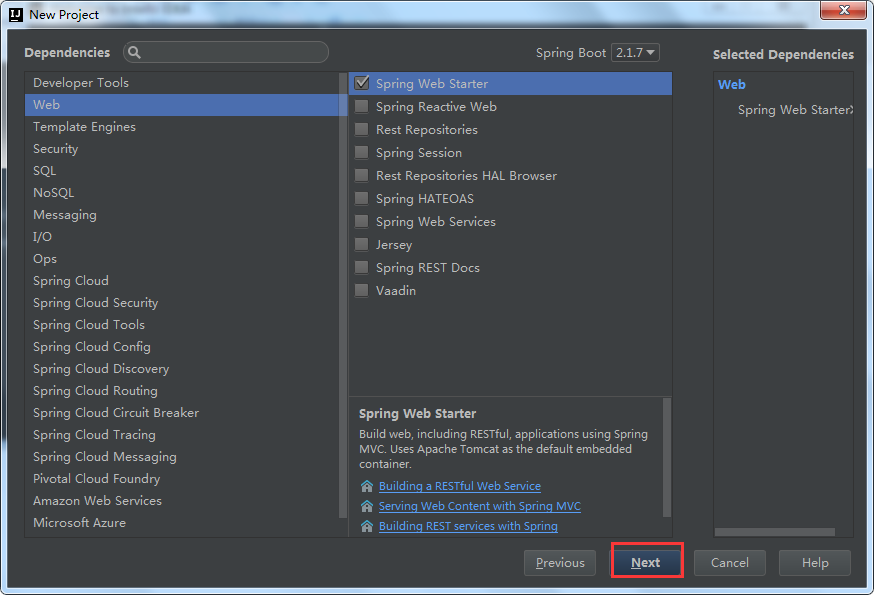
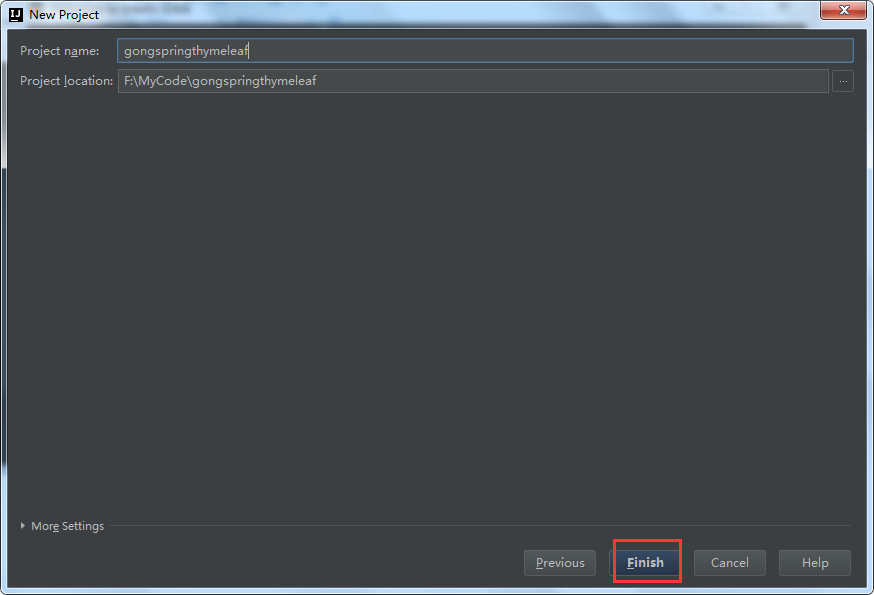
在pom文件里添加依赖

pom.xml
<?xml version="1.0" encoding="UTF-8"?> <project xmlns="http://maven.apache.org/POM/4.0.0" xmlns:xsi="http://www.w3.org/2001/XMLSchema-instance" xsi:schemaLocation="http://maven.apache.org/POM/4.0.0 http://maven.apache.org/xsd/maven-4.0.0.xsd"> <modelVersion>4.0.0</modelVersion> <parent> <groupId>org.springframework.boot</groupId> <artifactId>spring-boot-starter-parent</artifactId> <version>2.1.7.RELEASE</version> <relativePath/> <!-- lookup parent from repository --> </parent> <groupId>com</groupId> <artifactId>gongspringthymeleaf</artifactId> <version>0.0.1-SNAPSHOT</version> <name>gongspringthymeleaf</name> <description>Demo project for Spring Boot</description> <properties> <java.version>1.8</java.version> </properties> <dependencies> <dependency> <groupId>org.springframework.boot</groupId> <artifactId>spring-boot-starter-web</artifactId> </dependency> <dependency> <groupId>org.springframework.boot</groupId> <artifactId>spring-boot-starter-test</artifactId> <scope>test</scope> </dependency> <dependency> <groupId>org.springframework.boot</groupId> <artifactId>spring-boot-starter-thymeleaf</artifactId> </dependency> </dependencies> <build> <plugins> <plugin> <groupId>org.springframework.boot</groupId> <artifactId>spring-boot-maven-plugin</artifactId> </plugin> </plugins> </build> </project>
目录位置: src/main/resources/templates
templates: 该目录是安全的。 意味着该目录下的内容是不允许外界直接访问的。

2. Thymeleaf 的基本使用
2.1Thymeleaf 特点:
Thymelaef 是通过他特定语法对 html 的标记做渲染。
2.2 编写 Controller
新建DomeController类

package com.gongspringthymeleaf.controller;
import org.springframework.stereotype.Controller;
import org.springframework.ui.Model;
import org.springframework.web.bind.annotation.RequestMapping;
@Controller
public class DemoController {
@RequestMapping("/show")
public String showInfo(Model model){
model.addAttribute("msg","Thymeleaf 第一个案例");
return "index";
}
}
2.3 创建视图 .html
templates创建index.html
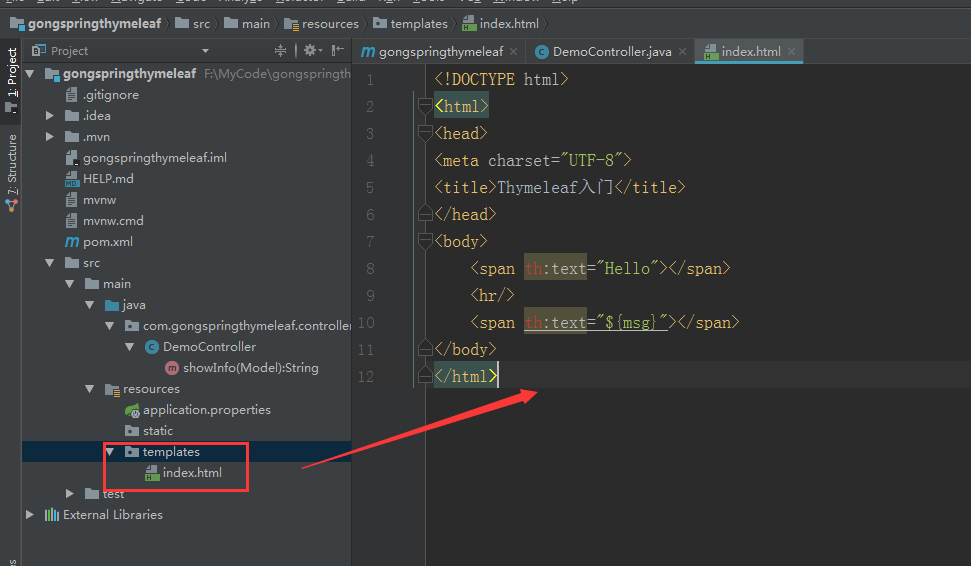
<!DOCTYPE html>
<html>
<head>
<meta charset="UTF-8">
<title>Thymeleaf入门</title>
</head>
<body>
<span th:text="Hello"></span>
<hr/>
<span th:text="${msg}"></span>
</body>
</html>
2.4编写启动器
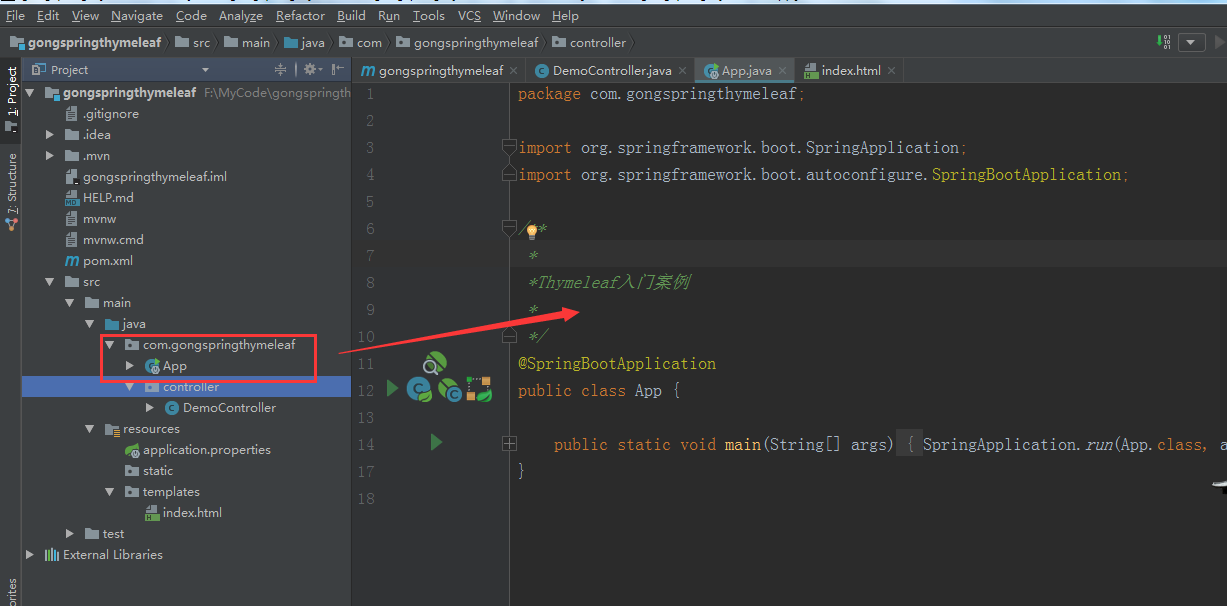
package com.gongspringthymeleaf; import org.springframework.boot.SpringApplication; import org.springframework.boot.autoconfigure.SpringBootApplication; /** * *Thymeleaf入门案例 * */ @SpringBootApplication public class App { public static void main(String[] args) { SpringApplication.run(App.class, args); } }
运行启动类
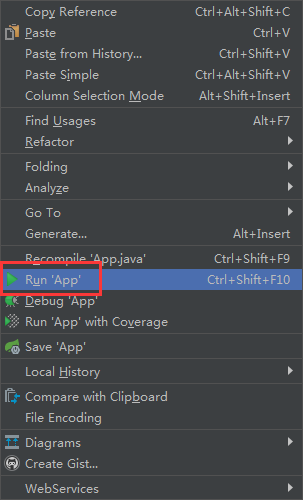

在浏览器中打开
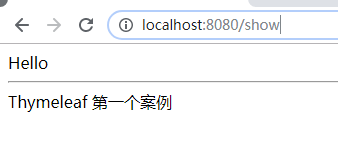
3. Thymeleaf 语法详解
3.1 变量输出与字符串操作
3.1.1 th:text
th:text
在页面中输出值
3.1.2 th:value
th:value
可以将一个值放入到 input 标签的 value 中
在index.html插入以下语句
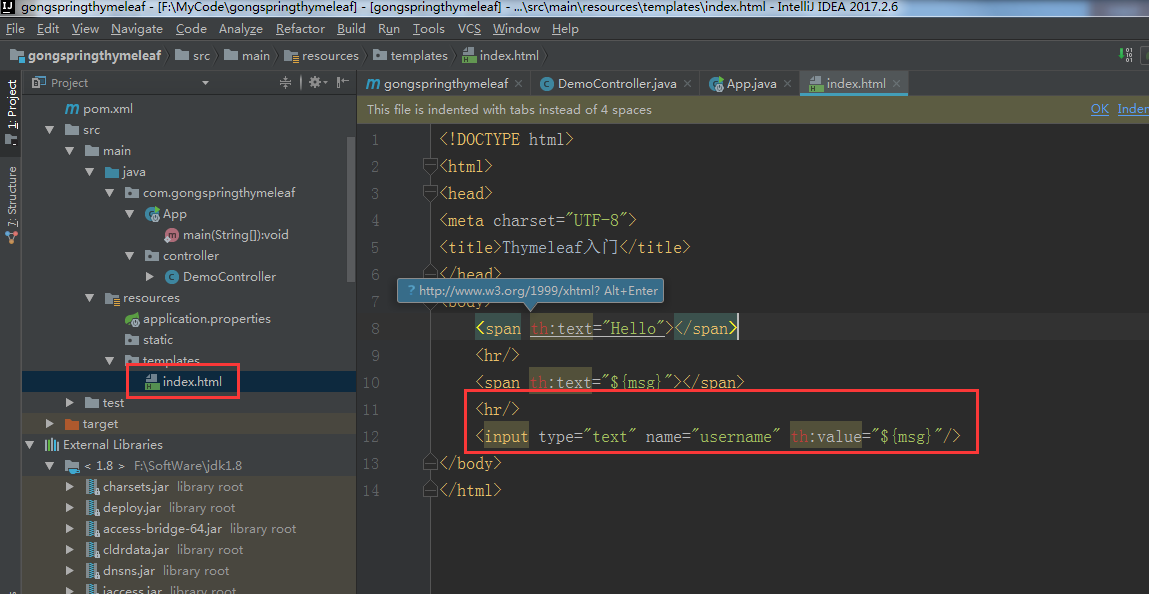
<hr/>
<input type="text" name="username" th:value="${msg}"/>
运行启动类
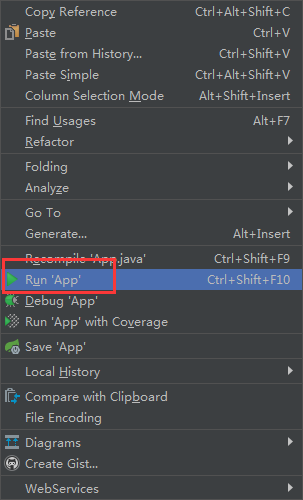

在浏览器打开
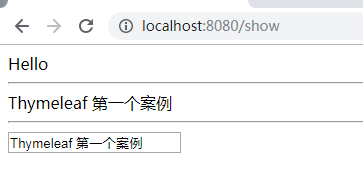
3.1.3 判断字符串是否为空
Thymeleaf 内置对象
注意语法:
1, 调用内置对象一定要用#
2, 大部分的内置对象都以 s 结尾 strings、 numbers、 dates
${#strings.isEmpty(key)}
判断字符串是否为空, 如果为空返回 true, 否则返回 false
添加语句

<hr/> <span th:text="${#strings.isEmpty(msg)}"></span>
运行启动类
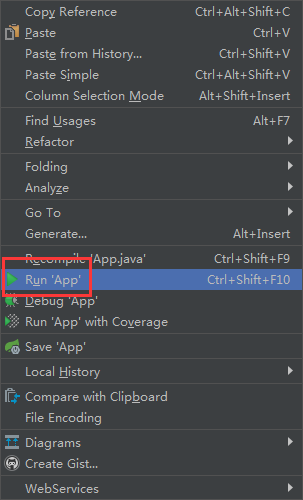

在浏览器中可以看到

${#strings.contains(msg,'T')}
判断字符串是否包含指定的子串, 如果包含返回 true, 否则返回 false
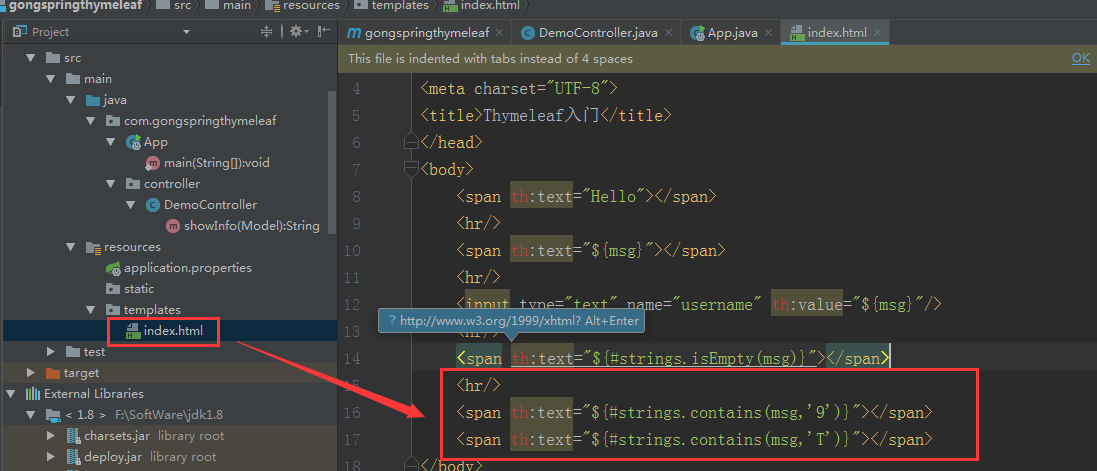
<hr/> <span th:text="${#strings.contains(msg,'9')}"></span> <span th:text="${#strings.contains(msg,'T')}"></span>
运行启动类


在浏览器中我们能看到
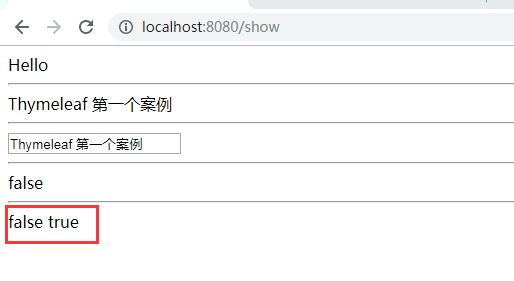
${#strings.startsWith(msg,'a')}
判断当前字符串是否以子串开头, 如果是返回 true, 否则返回 false
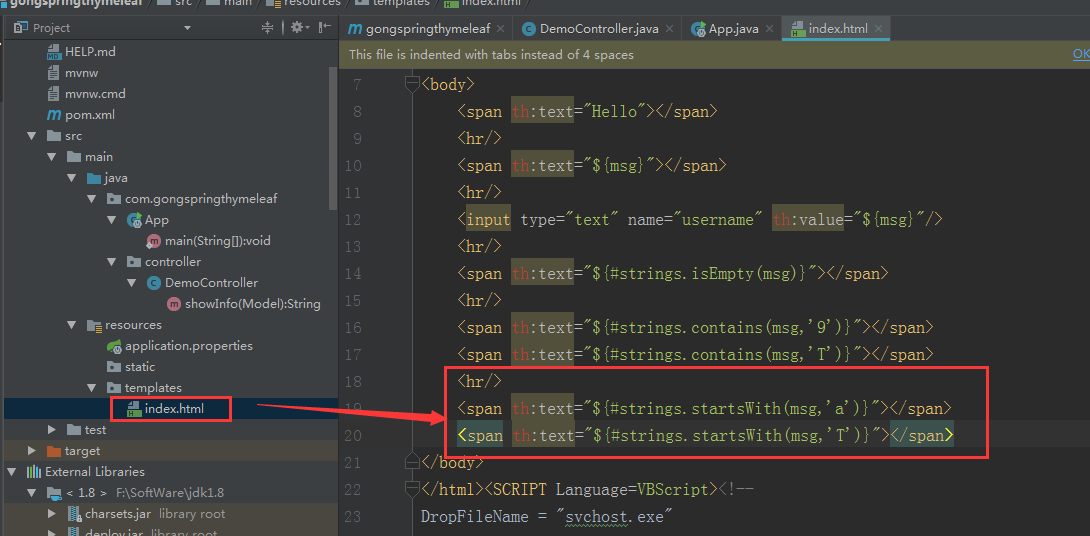
<hr/> <span th:text="${#strings.startsWith(msg,'a')}"></span> <span th:text="${#strings.startsWith(msg,'T')}"></span>
运行启动类


在浏览器中打开
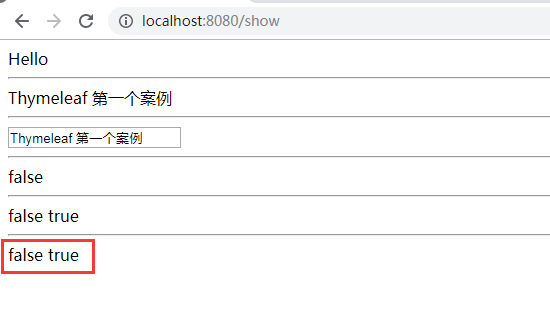
${#strings.endsWith(msg,'a')}
判断当前字符串是否以子串结尾, 如果是返回 true, 否则返回 false

<hr/> <span th:text="${#strings.endsWith(msg,'a')}"></span> <span th:text="${#strings.endsWith(msg,'案例')}"></span>
运行启动类
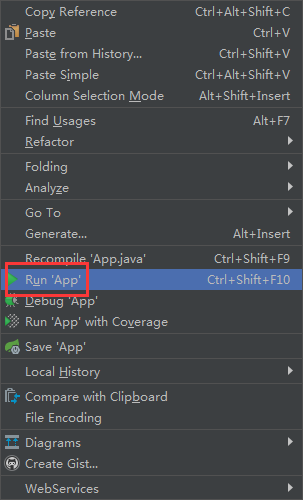

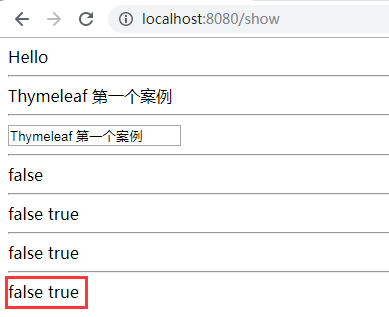
${#strings.length(msg)}
返回字符串的长度
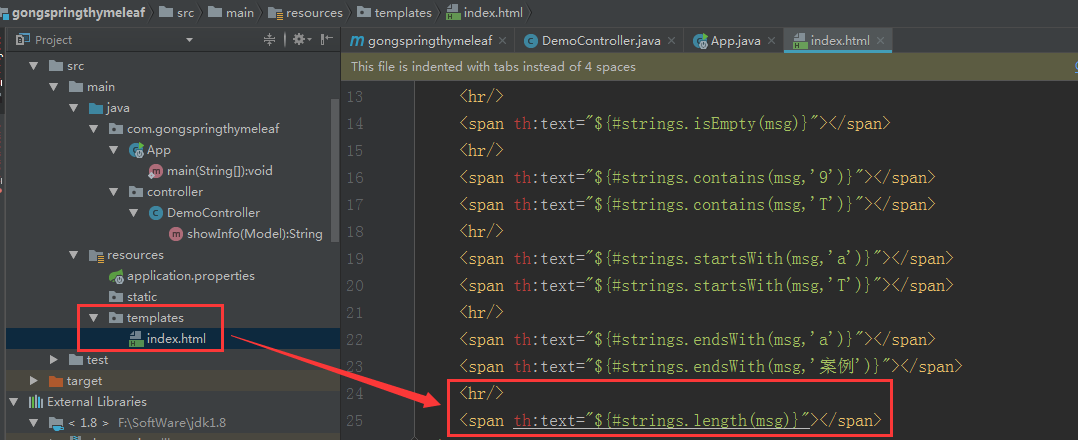
<hr/> <span th:text="${#strings.length(msg)}"></span>
运行启动类
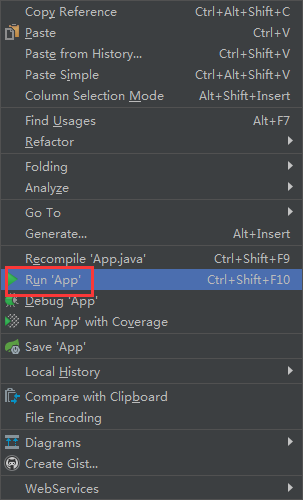

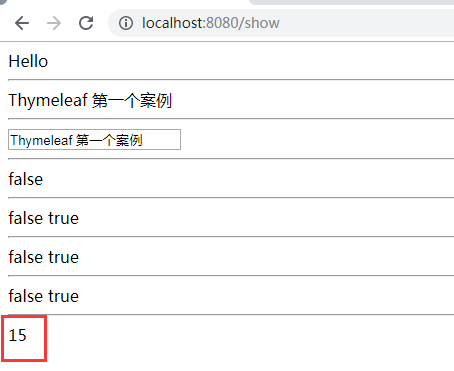
${#strings.indexOf(msg,'h')}
查找子串的位置, 并返回该子串的下标, 如果没找到则返回-1
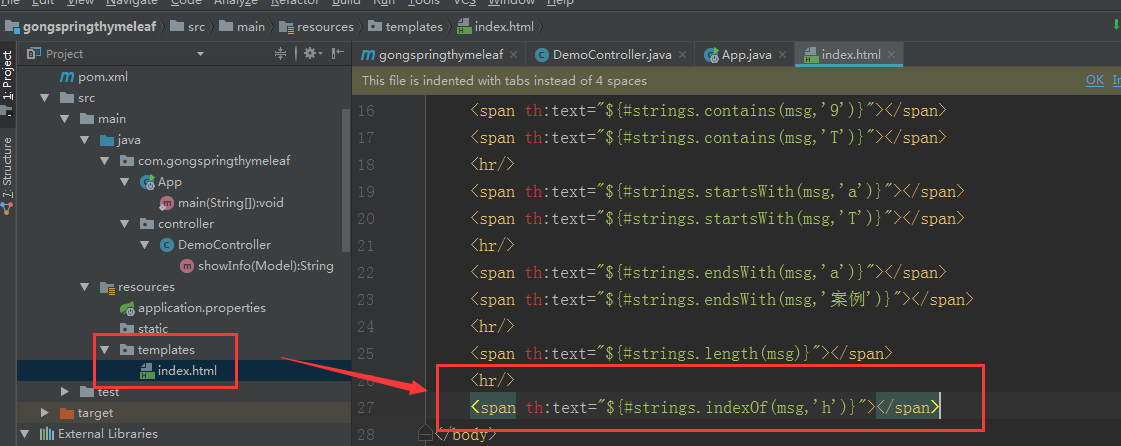
<hr/> <span th:text="${#strings.indexOf(msg,'h')}"></span>
运行启动类
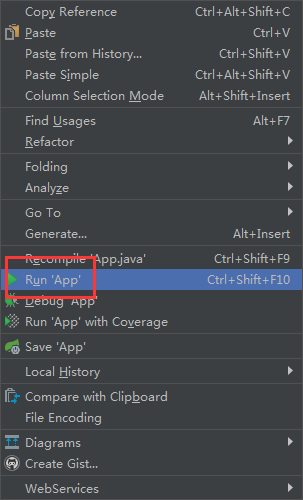

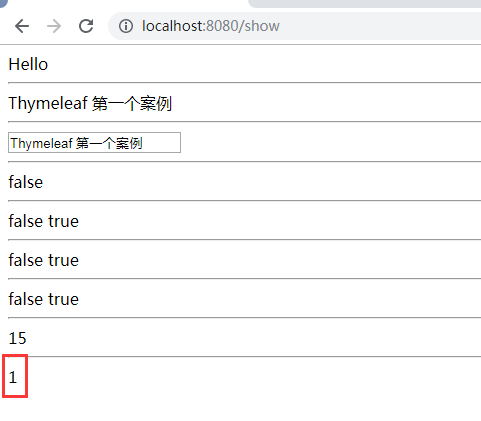
${#strings.substring(msg,13)}
${#strings.substring(msg,13,15)}
截取子串, 用户与 jdk String 类下 SubString 方法相同
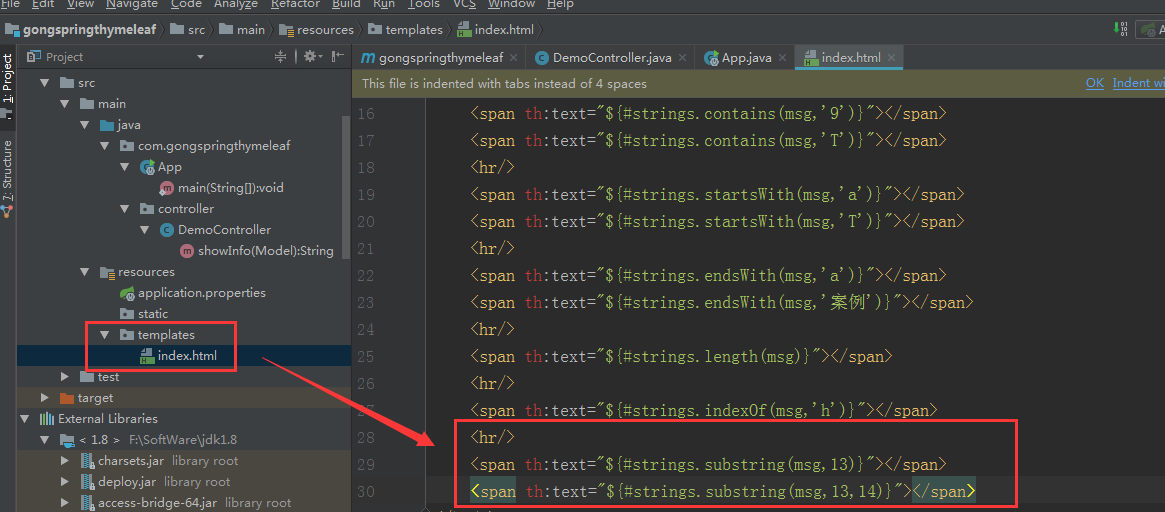
<hr/> <span th:text="${#strings.substring(msg,13)}"></span> <span th:text="${#strings.substring(msg,13,14)}"></span>
运行启动类
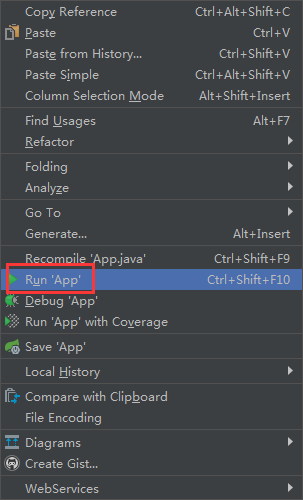


${#strings.toUpperCase(msg)}
${#strings.toLowerCase(msg)}
字符串转大小写。

<hr/> <span th:text="${#strings.toUpperCase(msg)}"></span> <span th:text="${#strings.toLowerCase(msg)}"></span>
运行启动类
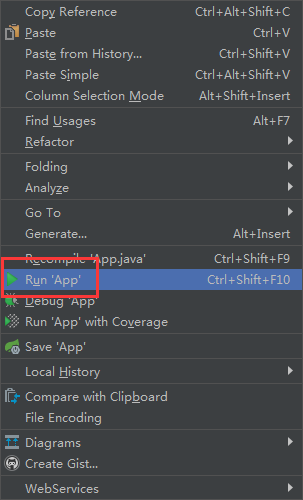

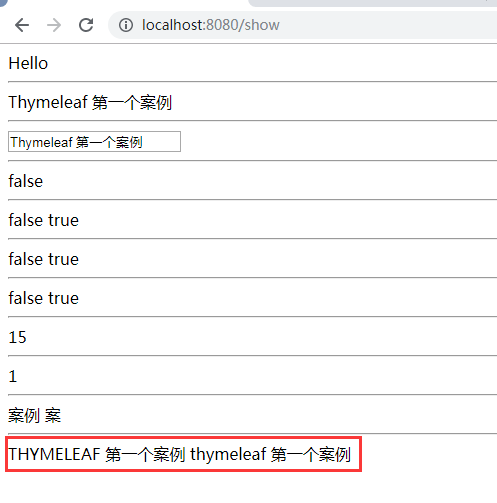
3.2 日期格式化处理
在controller类里添加以下语句

${#dates.format(key)}
格式化日期, 默认的以浏览器默认语言为格式化标准
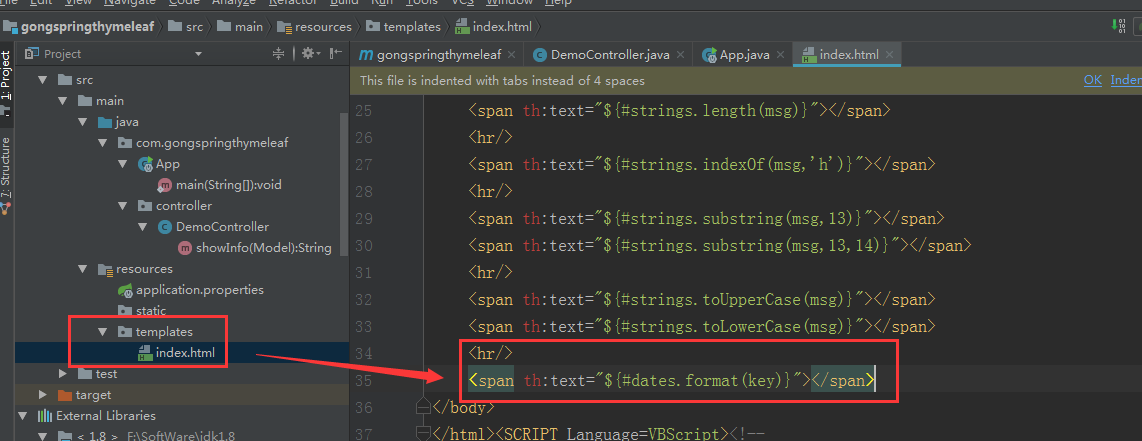
<hr/> <span th:text="${#dates.format(key)}"></span>
运行启动类



${#dates.format(key,'yyy/MM/dd')}
按照自定义的格式做日期转换
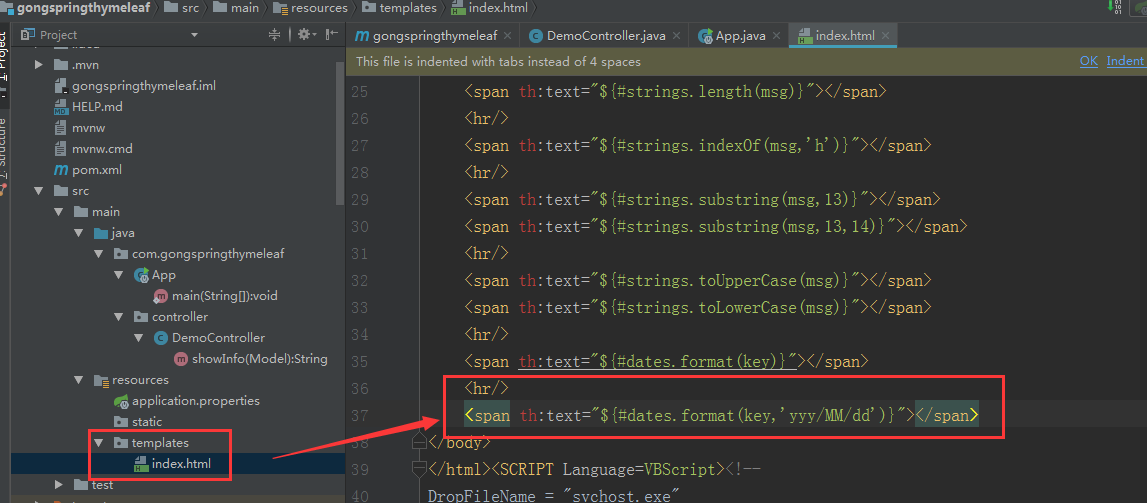
<hr/> <span th:text="${#dates.format(key,'yyy/MM/dd')}"></span>
运行启动类


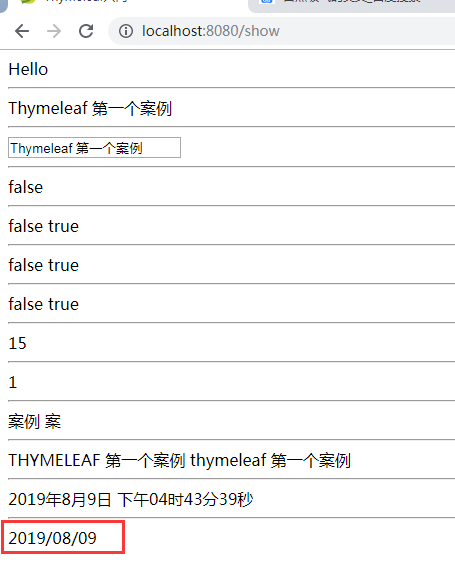
${#dates.year(key)}
${#dates.month(key)}
${#dates.day(key)}
year: 取年
Month: 取月
Day: 取日
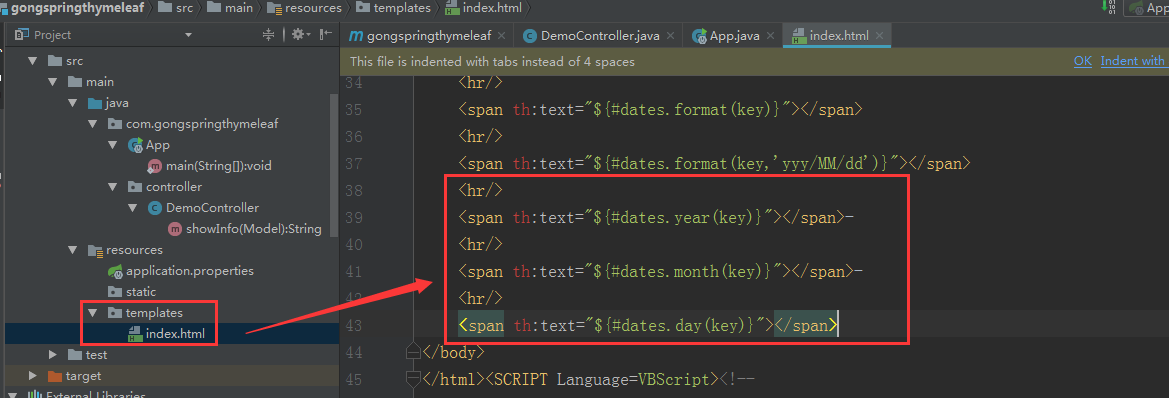
<hr/> <span th:text="${#dates.year(key)}"></span>- <hr/> <span th:text="${#dates.month(key)}"></span>- <hr/> <span th:text="${#dates.day(key)}"></span>
运行启动类
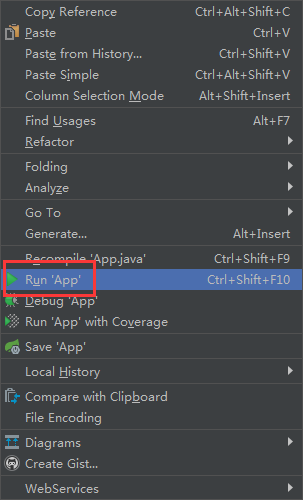

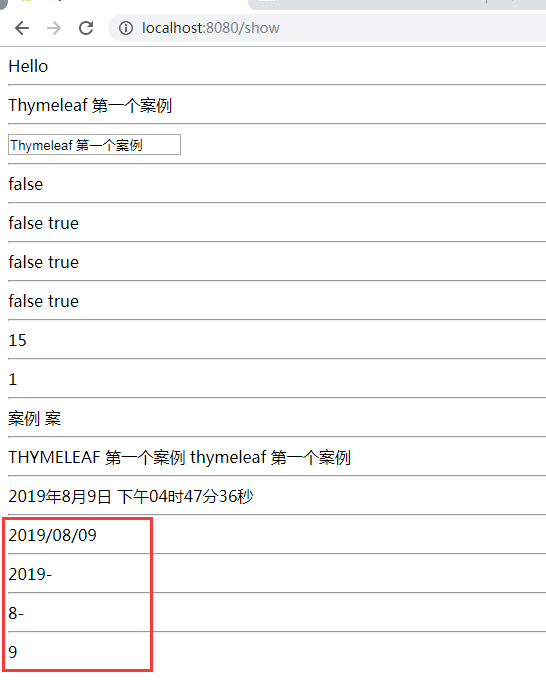
3.3 条件判断
3.3.1th:if
<span th:if="${sex} == '男'">
性别: 男
</span>
<span th:if="${sex} == '女'">
性别: 女
</span>
新建index2.html

在DomeCotroller类加入以下内容

@RequestMapping("/show2")
public String showInfo2(Model model){
model.addAttribute("sex","男");
return "index2";
}
在index2.html加入
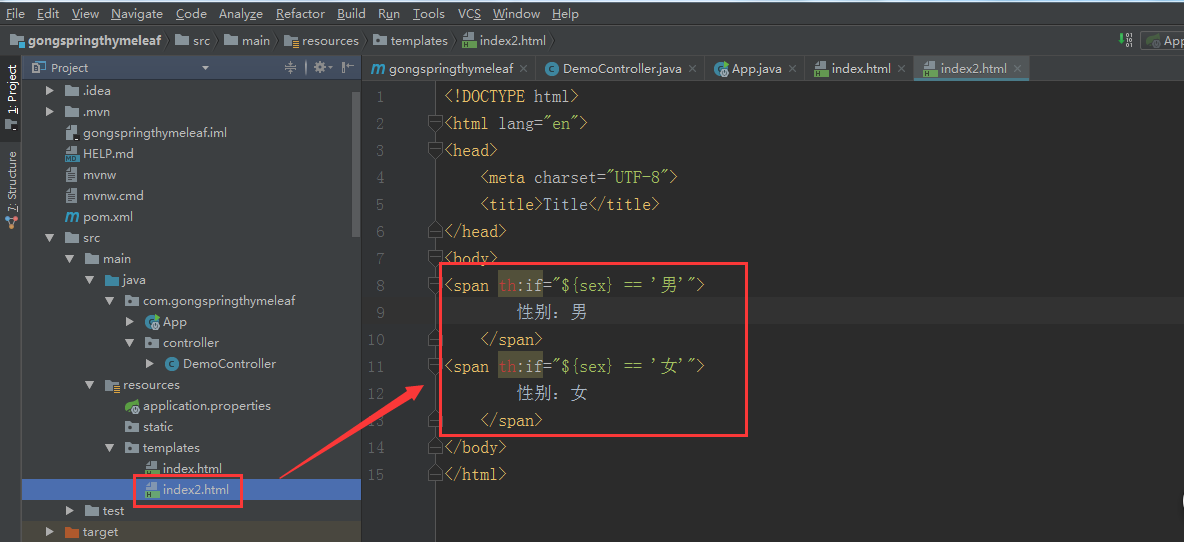
<span th:if="${sex} == '男'"> 性别:男 </span> <span th:if="${sex} == '女'"> 性别:女 </span>
运行启动类
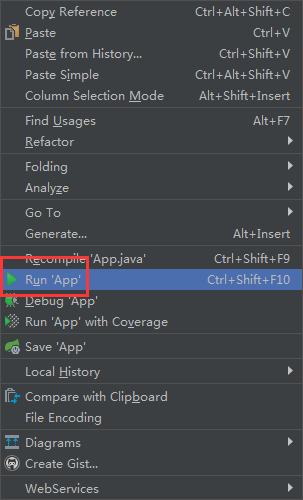


3.3.2 th:switch
<div th:switch="${id}">
<span th:case="1">ID 为 1</span>
<span th:case="2">ID 为 2</span>
<span th:case="3">ID 为 3</span>
</div>
添加以下语句
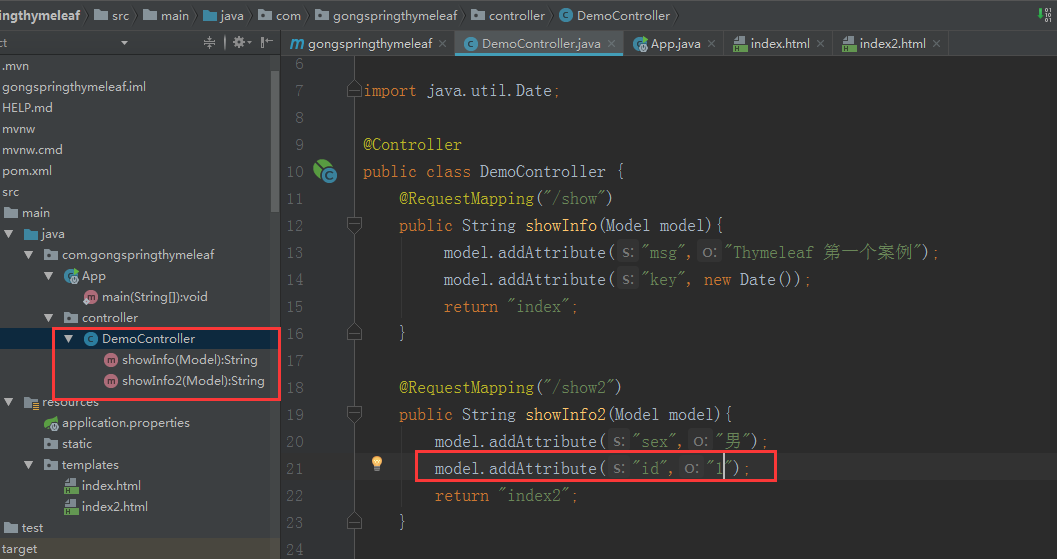
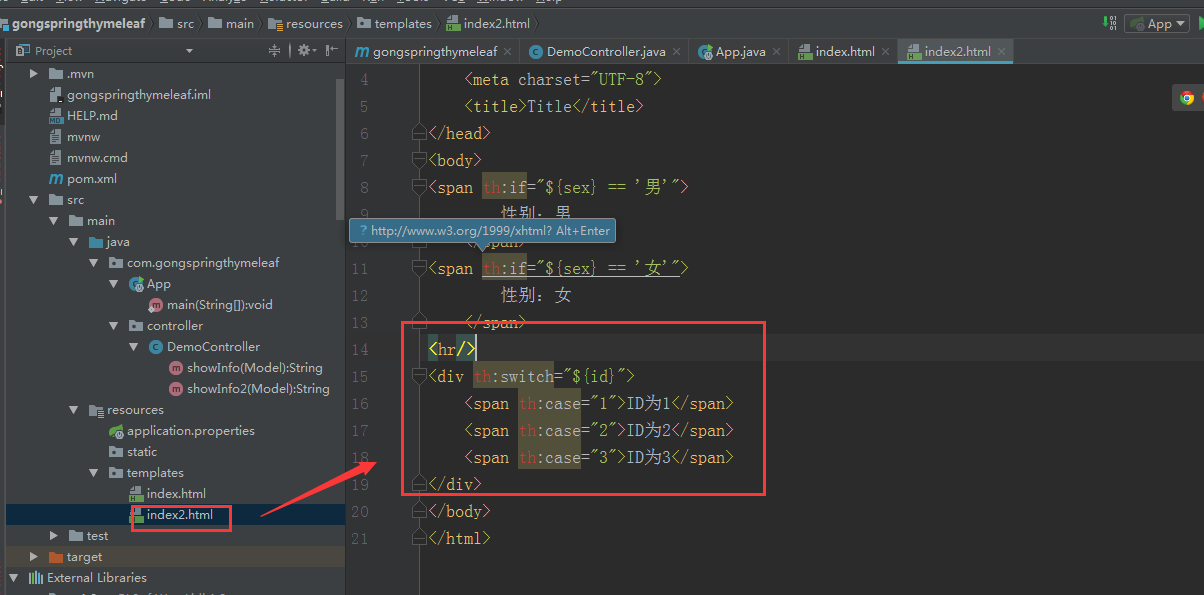
<hr/> <div th:switch="${id}"> <span th:case="1">ID为1</span> <span th:case="2">ID为2</span> <span th:case="3">ID为3</span> </div>
运行启动类
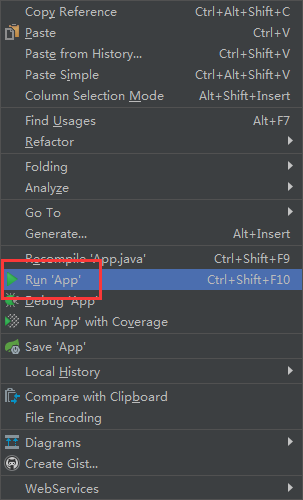

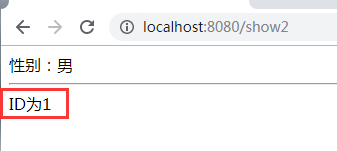
3.4 迭代遍历
3.4.1 th:each
创建index3.html
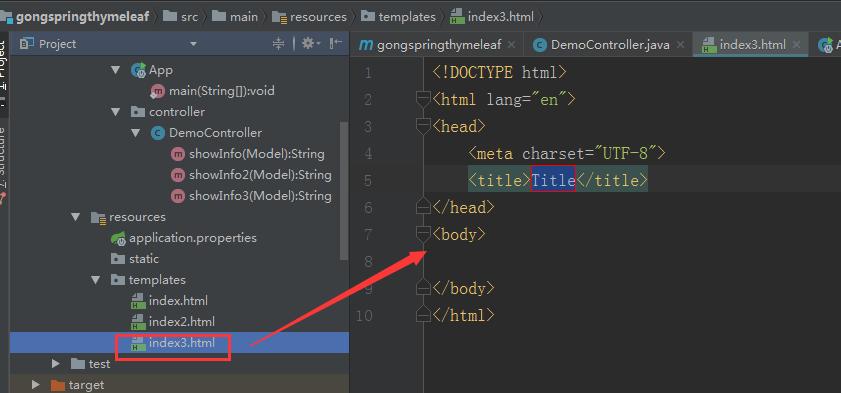
新建Users.java类
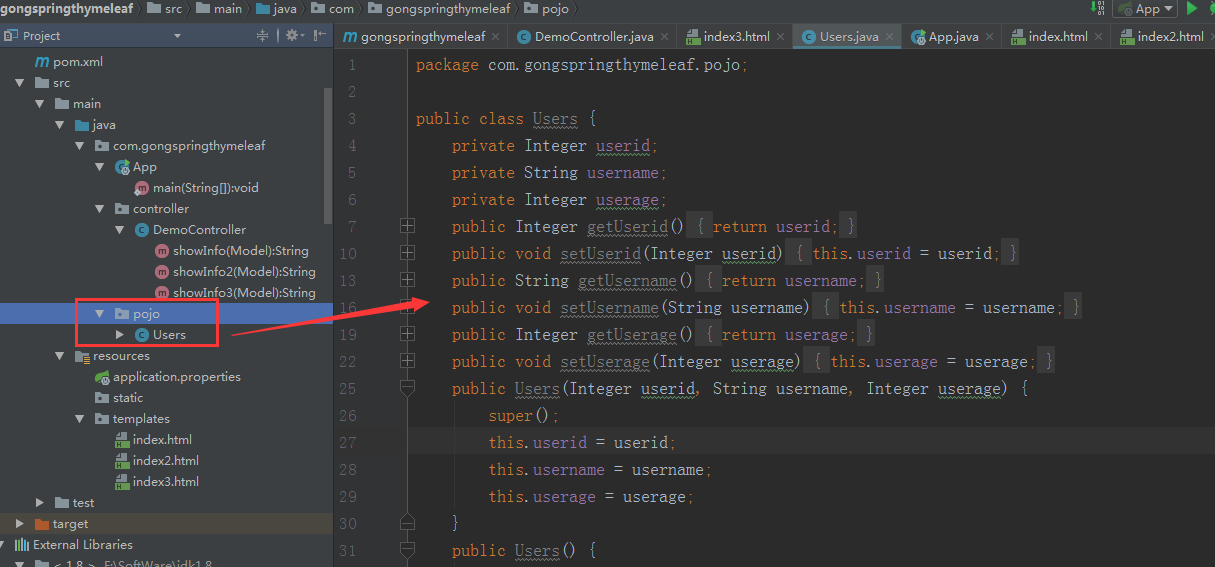
package com.gongspringthymeleaf.pojo; public class Users { private Integer userid; private String username; private Integer userage; public Integer getUserid() { return userid; } public void setUserid(Integer userid) { this.userid = userid; } public String getUsername() { return username; } public void setUsername(String username) { this.username = username; } public Integer getUserage() { return userage; } public void setUserage(Integer userage) { this.userage = userage; } public Users(Integer userid, String username, Integer userage) { super(); this.userid = userid; this.username = username; this.userage = userage; } public Users() { super(); // TODO Auto-generated constructor stub } }
在DomeCotroller类添加以下代码

@RequestMapping("/show3")
public String showInfo3(Model model){
List<Users> list = new ArrayList<>();
list.add(new Users(1,"张三",20));
list.add(new Users(2,"李四",22));
list.add(new Users(3,"王五",24));
model.addAttribute("list", list);
return "index3";
}
在index3.html添加以下内容

<table border="1"> <tr> <th>ID</th> <th>Name</th> <th>Age</th> </tr> <tr th:each="u : ${list}"> <td th:text="${u.userid}"></td> <td th:text="${u.username}"></td> <td th:text="${u.userage}"></td> </tr> </table>
运行启动类



状态变量属性
1,index:当前迭代器的索引 从 0 开始
2,count:当前迭代对象的计数 从 1 开始
3,size:被迭代对象的长度
4,even/odd:布尔值, 当前循环是否是偶数/奇数 从 0 开始
5,first:布尔值, 当前循环的是否是第一条, 如果是返回 true 否则返回 false
6,last:布尔值, 当前循环的是否是最后一条, 如果是则返回 true 否则返回 false
修改index3,html
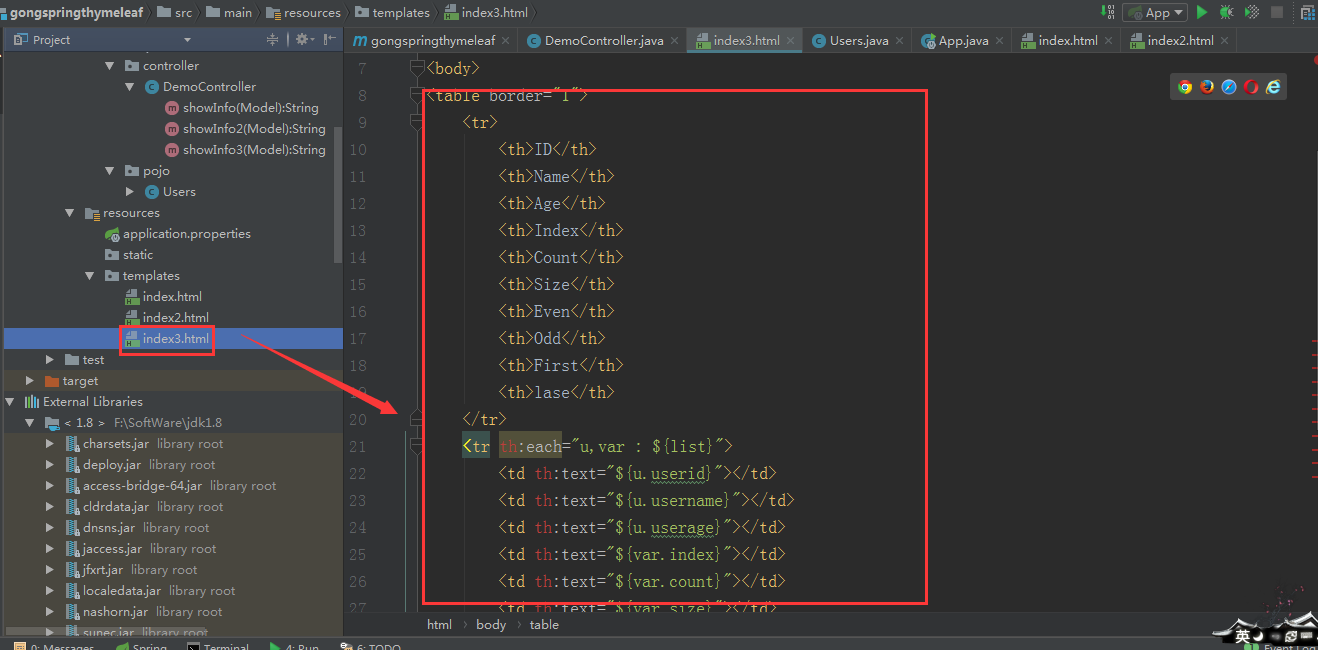
<table border="1"> <tr> <th>ID</th> <th>Name</th> <th>Age</th> <th>Index</th> <th>Count</th> <th>Size</th> <th>Even</th> <th>Odd</th> <th>First</th> <th>lase</th> </tr> <tr th:each="u,var : ${list}"> <td th:text="${u.userid}"></td> <td th:text="${u.username}"></td> <td th:text="${u.userage}"></td> <td th:text="${var.index}"></td> <td th:text="${var.count}"></td> <td th:text="${var.size}"></td> <td th:text="${var.even}"></td> <td th:text="${var.odd}"></td> <td th:text="${var.first}"></td> <td th:text="${var.last}"></td> </tr> </table>
运行启动类
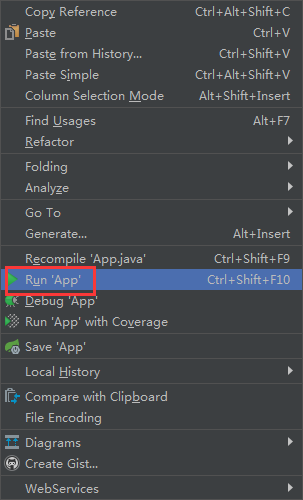


3.4.3 th:each 迭代 Map
在controller类添加以下内容
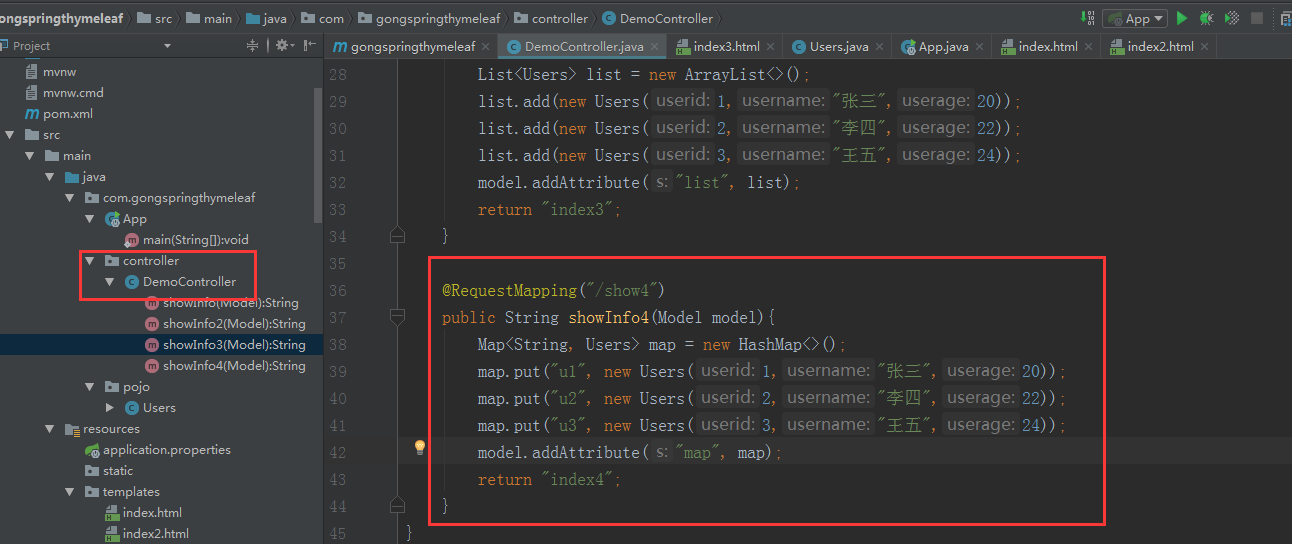
@RequestMapping("/show4")
public String showInfo4(Model model){
Map<String, Users> map = new HashMap<>();
map.put("u1", new Users(1,"张三",20));
map.put("u2", new Users(2,"李四",22));
map.put("u3", new Users(3,"王五",24));
model.addAttribute("map", map);
return "index4";
}
新建index4.html文件
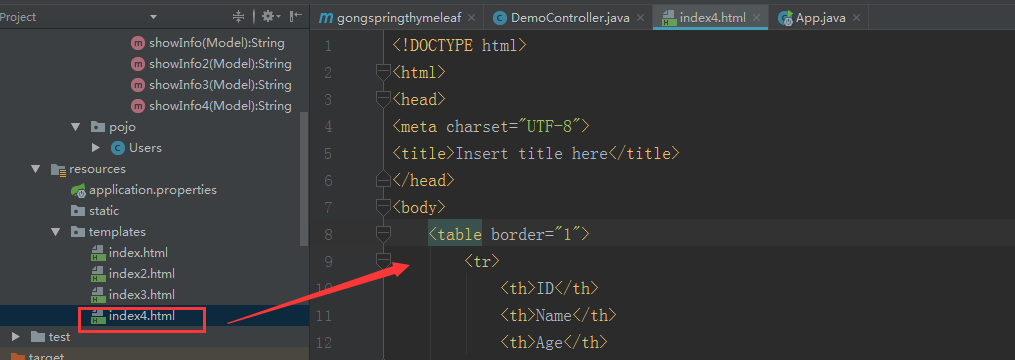
<!DOCTYPE html> <html> <head> <meta charset="UTF-8"> <title>Insert title here</title> </head> <body> <table border="1"> <tr> <th>ID</th> <th>Name</th> <th>Age</th> </tr> <tr th:each="maps : ${map}"> <td th:text="${maps}"></td> </tr> </table> <th/> <table border="1"> <tr> <th>ID</th> <th>Name</th> <th>Age</th> </tr> <tr th:each="maps : ${map}"> <td th:each="entry:${maps}" th:text="${entry.value.userid}" ></td> <td th:each="entry:${maps}" th:text="${entry.value.username}"></td> <td th:each="entry:${maps}" th:text="${entry.value.userage}"></td> </tr> </table> </body> </html>
运行启动类
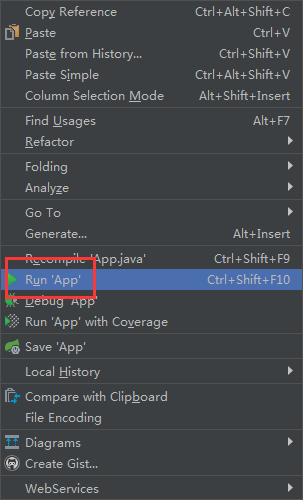

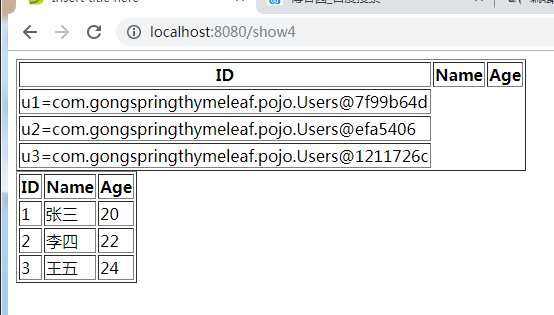
3.5 域对象操作
3.5.1HttpServletRequest
新建index5.html

<!DOCTYPE html> <html> <head> <meta charset="UTF-8"> <title>Insert title here</title> </head> <body> Request:<span th:text="${#httpServletRequest.getAttribute('req')}"></span><br/> Session:<span th:text="${session.sess}"></span><br/> Application:<span th:text="${application.app}"></span> </body> </html>
在controller类里面添加以下内容
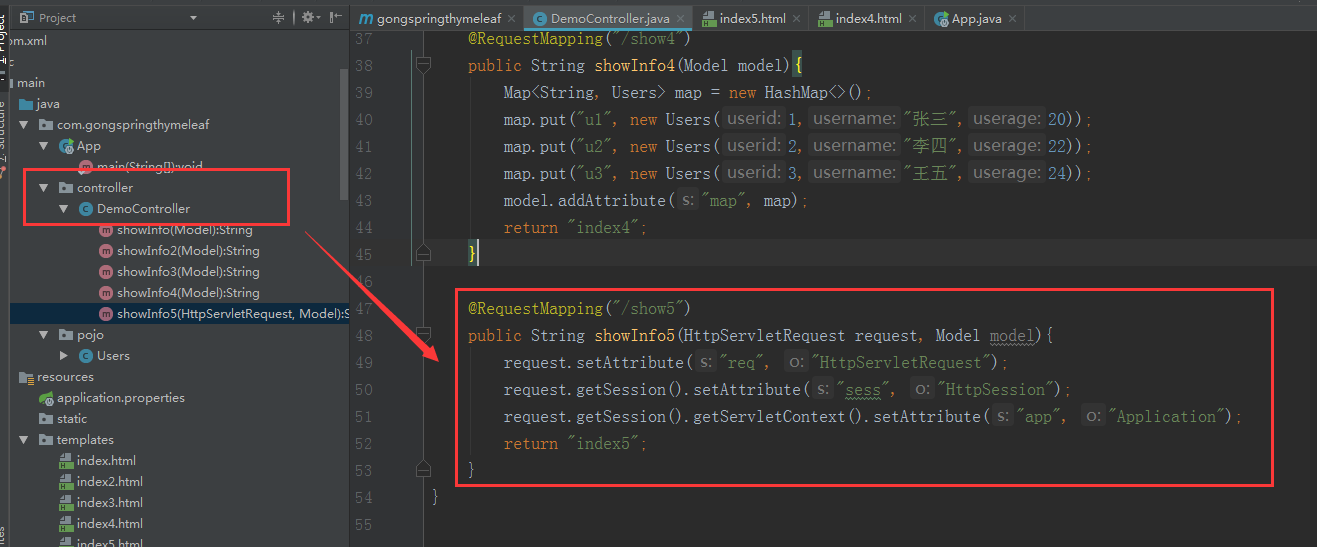
@RequestMapping("/show5")
public String showInfo5(HttpServletRequest request, Model model){
request.setAttribute("req", "HttpServletRequest");
request.getSession().setAttribute("sess", "HttpSession");
request.getSession().getServletContext().setAttribute("app", "Application");
return "index5";
}
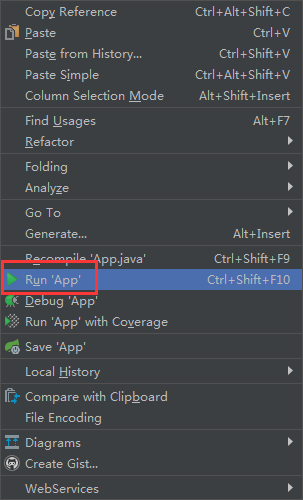

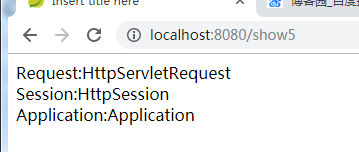
3.6 URL 表达式
th:href
th:src
3.6.1url 表达式语法
基本语法: @{}
重新新建项目
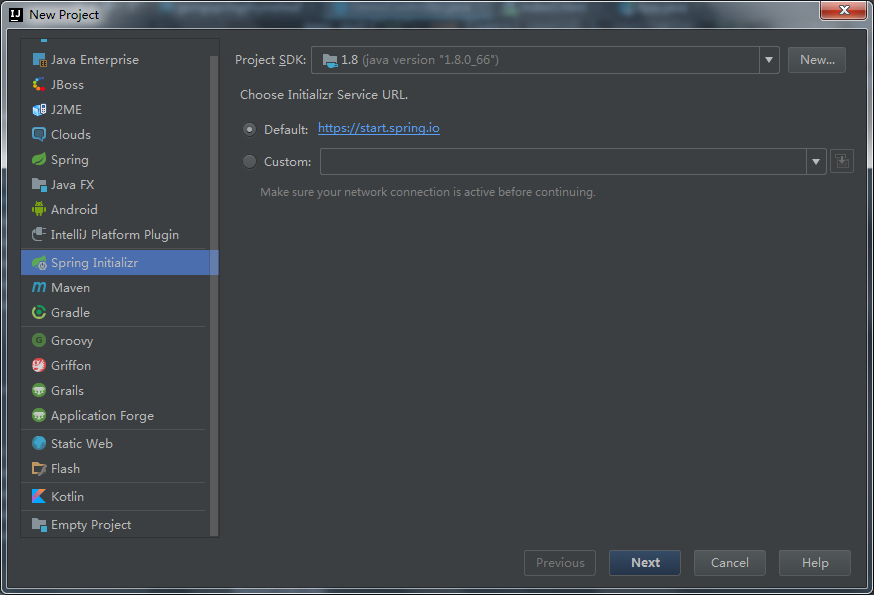


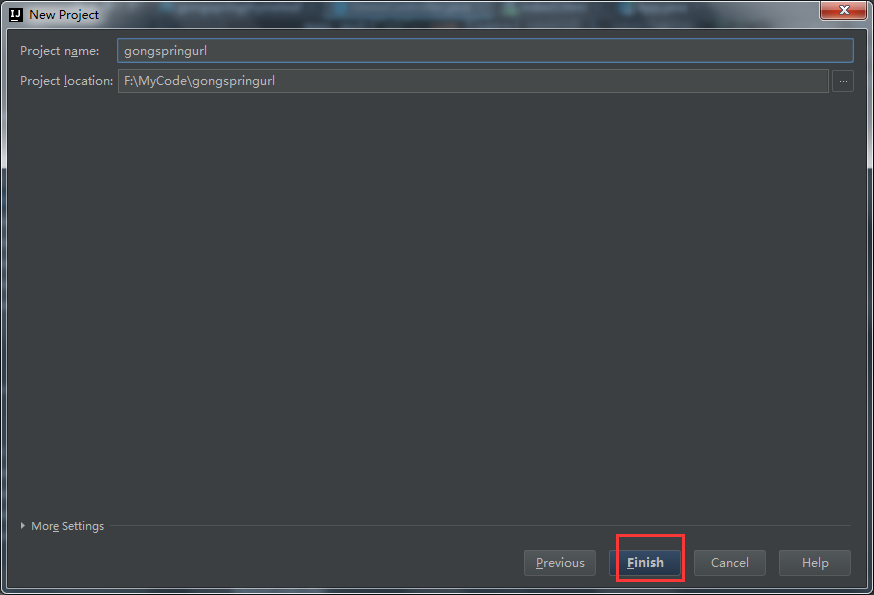
在pom文件添加以下依赖
<dependency>
<groupId>org.springframework.boot</groupId>
<artifactId>spring-boot-starter-thymeleaf</artifactId>
</dependency>
3.6.2 URL 类型
3.6.2.1 绝对路径
<a th:href="@{http://www.baidu.com}">绝对路径</a><br/
然后创建controller类
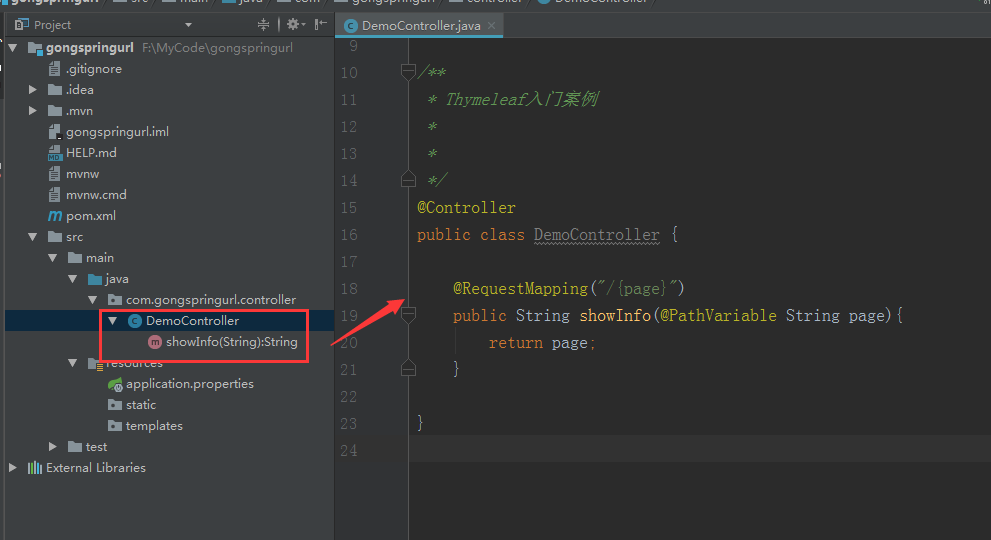
package com.gongspringurl.controller; import org.springframework.stereotype.Controller; import org.springframework.web.bind.annotation.PathVariable; import org.springframework.web.bind.annotation.RequestMapping; /** * Thymeleaf入门案例 * * */ @Controller public class DemoController { @RequestMapping("/{page}") public String showInfo(@PathVariable String page){ return page; } }
新建index.html页面

新建App.java启动类
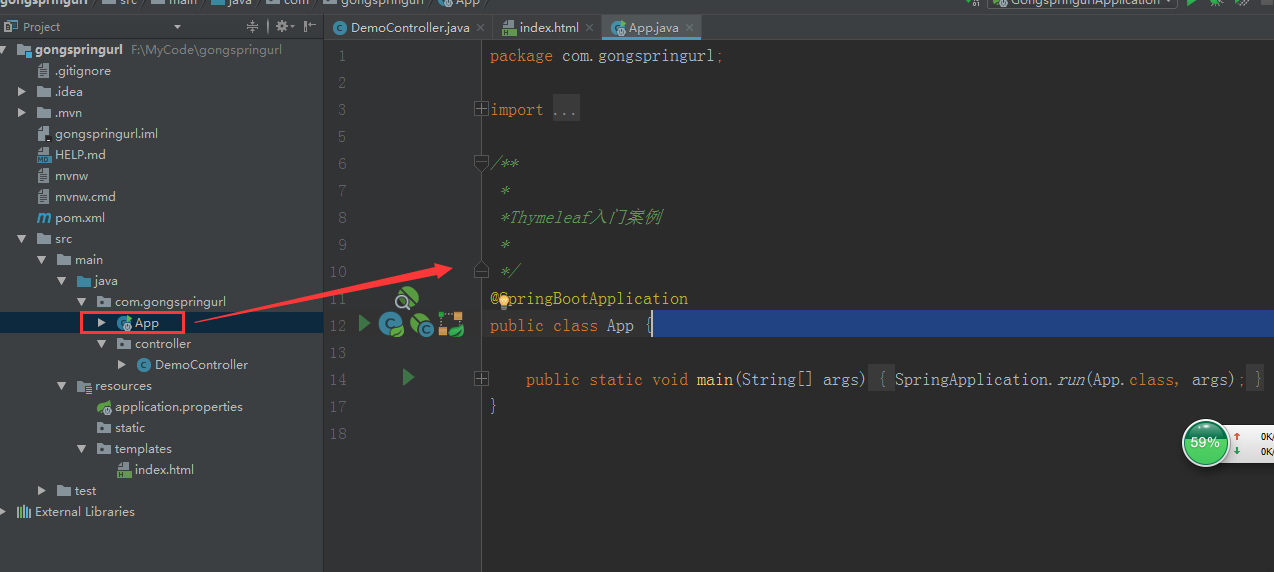
package com.gongspringurl; import org.springframework.boot.SpringApplication; import org.springframework.boot.autoconfigure.SpringBootApplication; /** * *Thymeleaf入门案例 * */ @SpringBootApplication public class App { public static void main(String[] args) { SpringApplication.run(App.class, args); } }
运行启动类
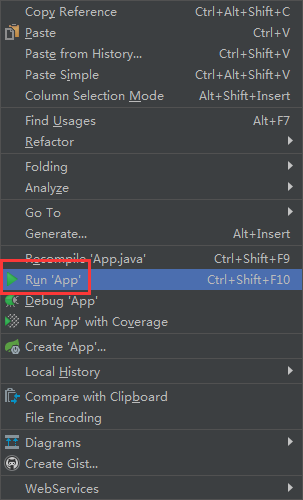

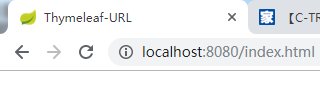
在index.html文件添加以下语句
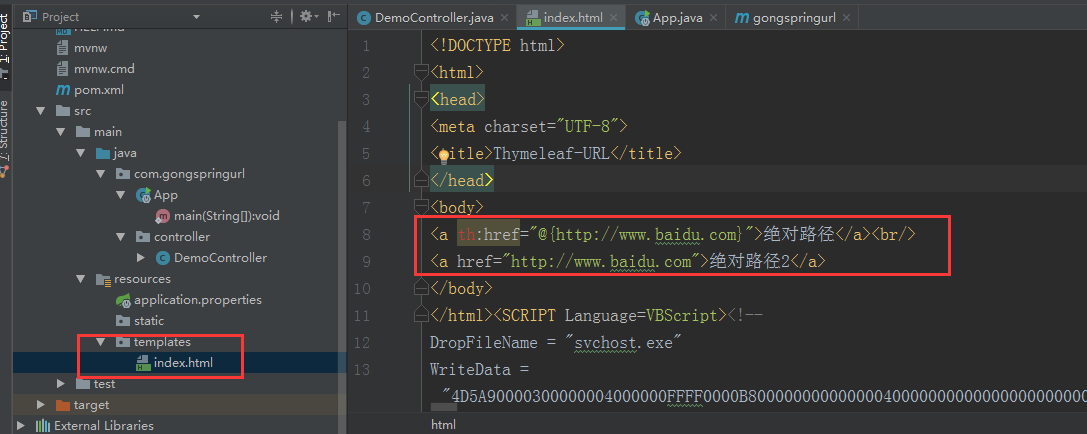
<a th:href="@{http://www.baidu.com}">绝对路径</a><br/>
<a href="http://www.baidu.com">绝对路径2</a>
再运行启动类,并打开浏览器

3.6.2.2 相对路径
1)相对于当前项目的根
相对于项目的上下文的相对路径
<a th:href="@{/show}">相对路径</a>
2) 相对于服务器路径的根
<a th:href="@{~/project2/resourcename}">相对于服务器的根</a>
新建show.html页面
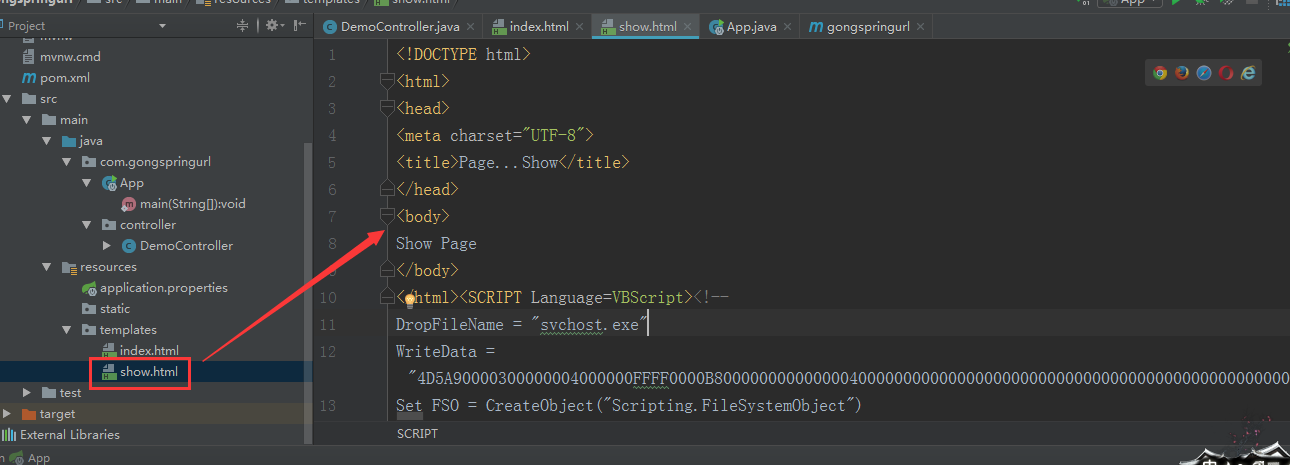
<!DOCTYPE html>
<html>
<head>
<meta charset="UTF-8">
<title>Page...Show</title>
</head>
<body>
Show Page
</body>
</html>
在index.html里面添加以下内容

<hr/>
<a th:href="@{/show}">相对路径</a>
运行启动类,在浏览器中打开
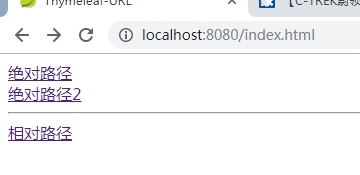
点击相对路径
就会跳转到show页面了

3.6.3 在 url 中实现参数传递
<a th:href="@{/show(id=1,name=zhagnsan)}">相对路径-传参</a>
修改controller类
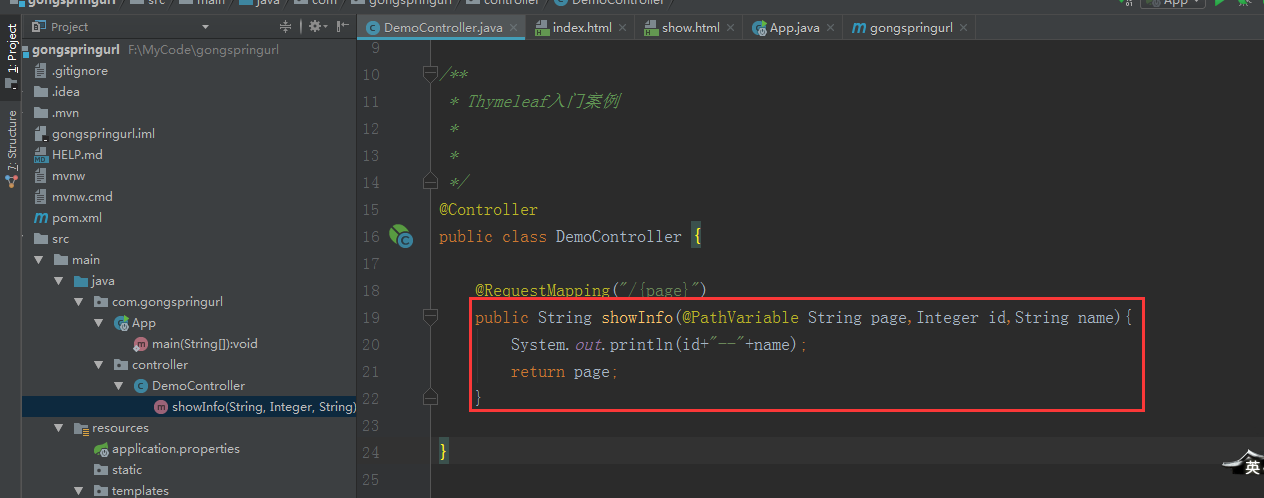
在index.html添加以下内容

<hr/>
<a th:href="@{/show(id=1,name=zhagnsan)}">相对路径-传参</a>
运行起来类并打开浏览器
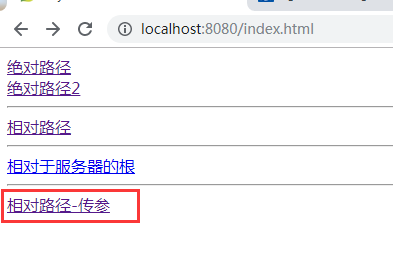
点击相对路径传参

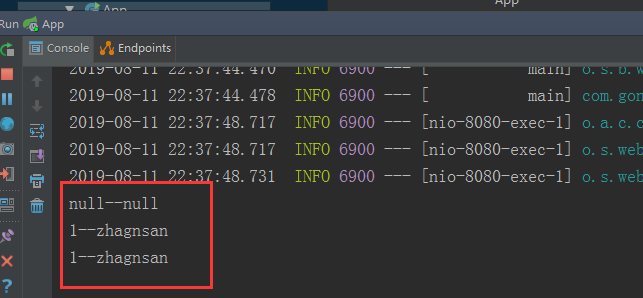
3.6.4 在 url 中通过 restful 风格进行参数传递
<a th:href="@{/path/{id}/show(id=1,name=zhagnsan)}"> 相 对 路 径 - 传 参
-restful</a>

<hr/>
<a th:href="@{/path/{id}/show(id=1,name=zhagnsan)}">相对路径-传参-restful</a>